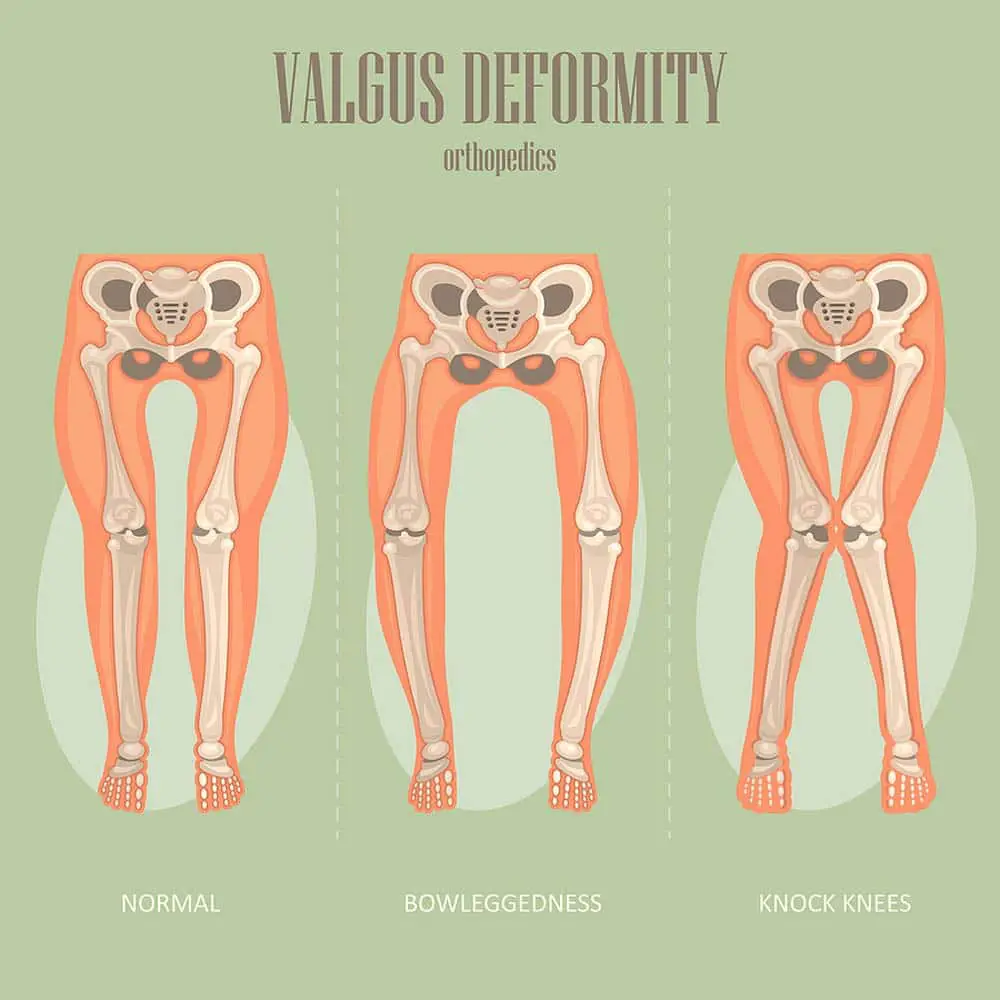Have you ever noticed that your knees bend inward?
You’re not alone.
Knee valgus, knock knees, or genu valgum (whatever you call it) all indicate the same thing: when someone’s knees bend inward toward the middle of the body.
For many people, especially young children, knee valgus isn’t a huge cause for concern. However, if you or someone you know has knock knees, then it’s essential that you have the information needed to decide if treatment is right for you.
What Is Knee Valgus?
Knee valgus (a.k.a. knock knees or genu valgum) is a condition where the legs curve inward toward the middle of the body. They shift inward at the knee, causing both knees to touch, even when the feet are far apart.
Knock knees are the opposite of bowlegs (genu varum). With bowlegs, the legs bend outward at the knee so that the knees don’t touch (even if the feet are right next to each other).
What Causes Knees To Bend Inward?
There are many reasons why someone might have knee valgus, but it’s important to note that the condition is much more common among children. In fact, the NHS reports that many children under the age of 4 have knock knees.
More often than not, knee valgus disappears on its own by the age of about 7. However, the condition can be caused by many different underlying issues in children. These include:
- Rickets – A condition in children that leads to weak bone formation. It can be caused by vitamin D deficiencies, kidney disease, tumors, genetics, or malabsorption problems.
- Injury – Serious injuries that affect the knees or leg bones could cause problems for growing children.
- Genetics – Some people are genetically predisposed to have bone or joint development issues.
- Obesity – Excessive pressure on the joints (particularly the knees) from obesity can cause issues with knee formation.
In adults, other causes are more likely. These include:
- Rheumatoid arthritis – An autoimmune form of arthritis that often causes joint pain and swelling.
- Osteoarthritis – The most commonly diagnosed form of arthritis. It’s often considered to be the result of “wear and tear” and is more common with age.
- Pediatric Orthopedic Issues – Unresolved or chronic orthopedic issues that crop up in childhood can lead to knock knees later in life.
That being said, especially in children and teens, knee valgus can be “idiopathic.” This means that the condition has no known cause and that it developed naturally on its own.
How Are Knock Knees Diagnosed?
Most of the time, knock knees are identifiable just based on physical appearance. For a second layer of assurance in the diagnosis, many physicians will order a standing X-ray, particularly on children.
After the X-ray is taken, radiologists and doctors will then draw a line onto the image from the hip to the ankle to see if the knee is sufficiently bent inward.
Particularly in children, doctors may order other tests to determine the underlying cause. This can include testing for vitamin D deficiencies, which could indicate rickets.
When Should I Be Concerned About Knee Valgus?
If you’ve noticed that you or your child has knees that bend inward, it’s best to see a physician who can refer you to a specialist. For people who aren’t sure whether they need a doctor, the NHS recommends that people see a physician if any of the following occur:
- There is a gap of more than 3″ (8cm) between the ankles when the knees are together.
- You notice that the problem is getting worse.
- There is an inward bend on just one knee.
- The knock knees develop during adulthood.
- There’s a sizable difference between the angle of the lower and upper legs when standing.
- You have knee pain or trouble walking.
- The condition has developed on a child over the age of 7 or under the age of 2.
When in doubt, it’s best to see a physician who can help steer you down the right path for treatment.
How To Fix Knock Knees
When children have knock knees, it usually goes away on its own before the age of 7 without any treatment. The Boston Children’s Hospital states that 99% of knock knees in children go away on their own.
However, in all other cases, the primary course of treatment is to deal with the underlying issue.
In addition to treating the underlying cause, there are other treatment options that an orthopedist or orthopedic surgeon might recommend. These include the following:
Surgery
Unless the knee valgus is very persistent or particularly severe, surgery isn’t typically necessary. When surgery is needed, there are 2 primary types:
- Osteotomy – With an osteotomy, a small portion of the tibia or femur bones is removed. This process is, as you can imagine, very invasive, so it’s generally not the first choice of treatment. Once the small wedge of the bone is removed, surgeons then use screws and plates to help realign the knees.
- Guided Growth – For children who are still growing, but that need surgery, guided growth is much more common. It involves inserting metal plates into the knee to help recorrect their positioning over the course of about 12 months.
Knee Braces & Orthotics
Some doctors will suggest that patients with knock knees try a knee brace to help alleviate some of the issues associated with the condition. While you can buy knee braces over the counter at many pharmacies, it’s generally best to discuss your options with a specialist physician first.
Another treatment option for some adults with mild knee valgus is orthotics. This is particularly useful for some adults whose knee valgus is caused by osteoarthritis. While orthotics are also available over the counter (similar to a knee brace), it’s usually best to first consult with a podiatrist or orthopedist about custom options.
Knock Knee Correction Exercises
Knock knee correction exercises are more commonly recommended for adults with osteoarthritis. As Harvard Medical School notes, the key to knock knee exercises is that pain should be avoided at all costs.
These exercises generally focus on strengthening the quads, hamstrings, glutes, and calves by biking, walking, stretching, strength training, and staying active.
For people whose knock knees are also associated with obesity and hip/back pain, exercises that focus on overall fitness, weight loss, and maintaining a healthy body fat percentage can go a long way.
For more personalized guidance on what exercises to do for knock knees, people should consult their physician, who can refer them to a physical therapist. Although general exercise is beneficial, each person with knee valgus should be evaluated by an expert who can advise on the best course of action with regards to treatment.








Leave A Comment